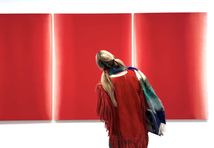The Lady from the Sea – 5 Stars
- The Courtauldian
- Mar 6, 2019
- 3 min read
I begin with a caveat. I don’t much like Ibsen. To be honest, I don’t much like a lot of ‘classic’ old (male) writers. I find Chekhov very stiff, Bernard Shaw formulaic, and I can’t stand Arthur Miller. Sorry-not-sorry. In light of this, the Norwegian Ibsen Company’s production of The Lady from the Sea (showing now at the Print Room at the Coronet, until 9th of March) was a pleasant surprise. Which is to say that it was really good.

The Lady from the Sea, Print Room (Source: Coronet | Print Room)
Marit Moumane’s company is part Norwegian, part English, and the dialogue is delivered in an amalgam of both languages. This is a canny decision as it plays into the themes of ‘difference’ and separation which are so tightly wrapped into Ibsen’s text. The central narrative focusses on the relationship between Wangel, a part-retired doctor played by Adrian Rawlins, and his new wife Ellida (Pia Tjelta). There is a fairy tale tone to Ellida’s otherness from her new family: she can’t connect with her step-children and her marriage to Wangel is fraught, as she longs to return to the north and her home. Mari Vatne Kjeldstadli’s script has interpreted Ibsen’s text as a modern feminist meditation on agency and vulnerability, as each female character is somehow under the power of a man, be that emotionally, physically or economically.
This disconnect between agency and isolation is reflected well in Erlend Birkeland’s set design: the ground is entirely covered with sand, but the back wall shows a huge backdrop of mountains and fjords. There is a suggestion of Soviet realist propaganda, but also of being imprisoned. The huge mountainous landscape looms above the actors, suggesting a sense of being trapped or locked in. Below the mountains is the entrance to the house, two large French windows; again, there is a feeling of closure and separation. Across the entire performance, characters unite and separate, but all are trapped in a kind of fishbowl atmosphere of frustration.

Marina Bye, Adrian Rawlins & Molly Windsor in a scene from The Lady from the Sea, Print Room, Coronet (Photo: Tristram Kenton)
Ellida is the classic ‘strong woman in a difficult situation’, featuring in so many plays of the period. These can seem a little stale these days, as it has become so cemented in our literature. But Tjelta manages to find a balance between vulnerable and autonomous, emphasising that it is her choice whether she leaves Wangel for her past lover, or stays in his house. One could render this decision as an examination of male entitlement, but Tjelta flips the coin and makes it a test of female independence. This is mirrored in the other two relationships, both of which feature men who unconsciously assume ownership of ‘their’ women. Marina Bye as Bolette perfectly captures the struggle of finding independence from masculine power and influence.
Perhaps there is a somewhat hidden metaphor underlying ‘The Lady from the Sea’: Ellida swims every morning, a plot point commonly understood as signifying her longing for the sea. Alternatively, one could understand this as a physical figuring of her position as a woman in a man’s world. In order to get what you want, do you have to swim with the current, or can you turn against the tide? Sure, no man is an island, but can a woman be independent of patriarchal forces without somehow, some-way utilising them to her advantage?












Comments